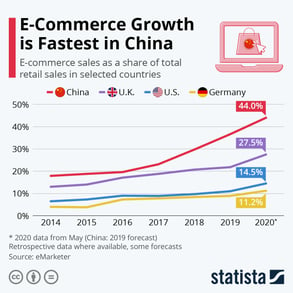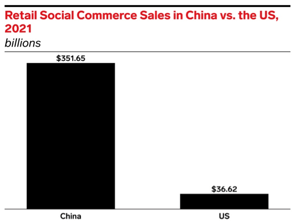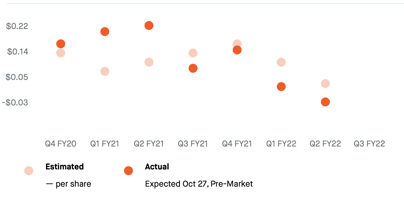Cold Chain Logistics: Management Challenges & Solutions
The supply chain is a term used to describe all the components required to transport goods from beginning to end, from production to the end...
-Aug-29-2022-10-44-57-01-PM.png)
As a brand, you may be wondering what the growth of eCommerce has looked like over the last few years and what it's projected to look like in the coming years. If you want to enter this market or are currently in it, it's very important to know this information.
Ecommerce has seen exponential growth since its inception. It bridges the necessity of shopping with the comfort of your home. Its growth skyrocketed during the pandemic because of the closure of physical stores. The only way for brands to survive was by selling online. And the only way to make purchases was through eCommerce. Consumers in 2022 are now more accustomed and comfortable with online shopping than ever.
In this article we will cover many aspects of how eCommerce has changed over the years. How much has it grown? What are the most recent industry trends? How is social media making an impact? How have platforms like Shopify and WooCommerce performed?
The graph below demonstrates just how fast eCommerce is growing. It shows retail eCommerce sales worldwide from 2014 – 2025. This is a good representation of how quickly this industry can grow and what to expect in the coming years.
In the span of 12 years its projected that sales will go from 1,336 billion to 7,391 billion. That’s massive growth! As analytics, AI, and machine learning get more and more advanced, this space will become even more lucrative. These advancements will greatly increase the effectiveness of ads and marketing, thus creating more sales and expanding your audience.
 Over the last few years, China has pulled away from the rest of the world in eCommerce sales. They are a huge market and any brand wanting to expand outside of the US should look at shipping to China.
Over the last few years, China has pulled away from the rest of the world in eCommerce sales. They are a huge market and any brand wanting to expand outside of the US should look at shipping to China.
Lots of brands struggle with international shipping. Sometimes brands feel too overwhelmed to know where to start. Others spend countless hours researching and working toward compliance. Although this can be a difficult process, BUKU works with our clients to easily give them international access. This allows even the smallest brands the ability to expand outside of the US and reach new markets.

In this graph, you can see just how dominant China is compared to the US in Social commerce sales. Meaning purchases off social media such as Facebook, Instagram, WeChat, etc. This is has become an extremely popular way of shopping for them. With the new Shopify integration, it is likely that growth in Social Commerce sales will start to increase in the US over the next few years. But we will discuss that further in the Social Media portion of this article.
This growth will continue as it slowly gains on traditional brick-and-mortar stores. Although, as eCommerce grows, many brands also decide to open a physical location. As the world comes back from the pandemic we will, and have already seen, the pendulum swing away from online shopping. Traditional storefronts have been more popular as of late because of the appeal to be out with people doing things that weren't allowed for two years. Eventually things will balance out, but if eCommerce sees a small hit in 2022 that would be the reason why.
As the eCommerce industry continues to grow, you need to be paying attention to the trends. Being on the wrong side of a trend can be devastating, while successfully launching a product that fits with trends can greatly increase sales and brand effectiveness.
Consumers are pushing more and more for their favorite brands to become as sustainable as possible. Brands are publicly sharing how they're becoming sustainable and are celebrated. On the flip side, companies that still use environmentally impactful practices are shunned.
This trend is here to stay and will get increasingly more prevalent as time goes on. As a brand, it is important to communicate with your audience how exactly you are striving for change. There are simple ways you can have an impact, whether that's with packaging, shipping, materials, etc. There is always something you can do and share to be able to retain and capture consumers.
To learn more about the importance of sustainable business practices, read our past blog: Ecommerce Brands and Sustainability.
Crypto's popularity has spiked over the last five years. NFT's, Bitcoin, Cryptocurrencies are all words we know by now. Ecommerce has become intertwined with gated products, NFT's, etc.
Companies like Adidas, Nike, Microsoft, and many others have all become involved in this industry in one way or another. And now, with integrations, like the one with Shopify with Tokengating, it becomes easier and easier for smaller brands to become part of this wave.
Although it is popular and lucrative, it can also be very volatile. We recommend you do extensive research before entering into this space.
To learn more about Tokengating and Crypto influence in eCommerce, read our past blog: Understand Shopify's newest feature: Tokengated Commerce
Delivery times have become a huge focus for consumers over the last few years. They have become accustomed to an "Amazon" like experience across all platforms. To give this to them, you need to be able to offer multiple lanes, free shipping, and accurate and fast delivery times. This can be a lot of pressure on a brand. Going from a single flat rate lane to exceeding customer experience expectations is difficult on your own.
Luckily BUKU is a great partner for this. We enable your brand to offer a shipping experience that your customers will love. Easily add multiple lanes, display accurate delivery dates, strategically provide free shipping, and more. These upgrades will allow you to keep up with and exceed customer expectations for your brand.
Schedule a free demo with us today to see how you can improve your shopping cart experience. Click here
Social media has had a huge impact on eCommerce sales. Being able to display your product, have a social presence, create a brand personality, connect with customers, and directly link your store has given brands new room for growth. Not to mention the many social media influencers are now selling products online, continuing the progression of eCommerce stores.
In some parts of the world, such as China, we have already seen its usefulness and effectiveness to help sell products. In 2022 they are projected to have 14.4% of all sales be Retail Social Commerce sales. Compared to 4.4% in the US. The US has a ways to go, but there has been promising growth and recent news that shows just how important social media eCommerce will be. For example, Shopify announced that it will be partnering with Twitter to allow users to access and purchase from Shopify stores. This limits friction and allows for a more seamless purchasing process. Partnerships like this greatly impact the efficiency and popularity of social commerce.
In a recent study, Sprout Social stated, "The future of social commerce is already here with 68% of consumers making at least one purchase directly from social media in 2021.
Whether shoppers are expanding their local purchasing opportunities or engaging in their virtual communities to buy across borders, they’re turning to Facebook Shops, Instagram Shopping, and TikTok Shopping.
And social shopping isn’t slowing down—98% of consumers plan to make at least one purchase through social shopping or influencer commerce in 2022." (Sprout Social)
Brands should start looking into this form of eCommerce as it will continue to grow in popularity in the US and abroad.
There is a multitude of eCommerce platforms available for brands to use. Shopify remains at the top of the list when talking about market share. This is because they follow market trends and give their customers a simple way to start their eCommerce business.
These platforms can help you take your business to the next level and give you room to personalize your online store. Some of the most popular brands choose Shopify for their eCommerce platform. Brands such as: Gymshark, GFuel, Ridge Wallets, Allbirds, etc. This gives smaller brands more trust in Shopify as a platform. If very successful brands use it, I should as well.
"Shopify is the ecommerce company with the highest market cap (182.1 billion U.S. dollars by June of 2021). It was only surpassed by online marketplaces like Alibaba and Amazon in the technology industry" (eCommerce Guide)
Shopify, especially during the pandemic, saw dramatic growth which has shot it into the spotlight. It has since seen a decline in earnings and has missed earnings expectations multiple times.
But as of 2022 Shopify is still king for the average brand. If you have specific requirements, do research and find out which platform would be most accommodating for you. As for the majority of stores, Shopify is easy to use, well known, and has thousands of plug-in apps such as BUKU's IntelliRate that you can use to differentiate yourself from the competition and personalize your brand further.
Takeaways
The growth of eCommerce is apparent. It will continue to spread as more brands are created every day. To compete and have success, you need to be able to follow customer expectations and trends. The ones we spotlighted for 2022 were: Sustainability, Crypto, and Shipping Delivery. By paying attention to competition and understanding your clients, you will be able to find trends to boost your business.
Social commerce is the newest way to promote your brand and tap into a new consumer marketplace. It's easy to connect with and can pay high dividends if done correctly. This form of eCommerce will only continue to grow in popularity both domestically and internationally.
Shopify remains at the top. It holds the highest market share and has been the platform that millions of brands choose to trust. Although it has taken some hits recently, the overall trajectory of eCommerce will help it to grow.
Sources:
Chevalier, Stephanie. “Global Retail e-Commerce Sales 2021-2025.” Statista, 22 Aug. 2022, https://www.statista.com/statistics/379046/worldwide-retail-e-commerce-sales/.
Editors, Insider Intelligence. “Social Commerce Surpasses $30 Billion in the US.” Insider Intelligence, Insider Intelligence, 7 July 2021, https://www.insiderintelligence.com/content/social-commerce-surpasses-30-billion-us.
Gaubys, Justas. “Global Ecommerce Sales Growth (2020–2025) [May 2022 Update].” Oberlo, Oberlo, https://www.oberlo.com/statistics/global-ecommerce-sales-growth.
“Ecommerce Statistics 2022 [Data and STATS Updated Monthly].” Ecommerce Guide, 29 Mar. 2022, https://ecommerceguide.com/ecommerce-statistics/.
“The Future of Ecommerce + Trends 2022.” Shopify, https://www.shopify.com/research/future-of-commerce/future-of-ecommerce.
“Social Commerce Penetration in China and the US, 2017-2023 (% of Total Retail Ecommerce Sales).” Insider Intelligence, Insider Intelligence, 1 Jan. 2021, https://www.insiderintelligence.com/chart/243527/social-commerce-penetration-china-us-2017-2023-of-total-retail-ecommerce-sales.
“Social Shopping in 2022: Consumer Behaviors in the Social Shopping Cart.” Sprout Social, 23 Feb. 2022, https://sproutsocial.com/insights/data/social-shopping-2022/.
“ECommerce Usage Distribution in the United States.” ECommerce Technologies Web Usage Distribution in the United States, https://trends.builtwith.com/shop/country/United-States.
Chevalier, Stephanie. “Market Cap Value of Top Consumer Internet Index Companies 2021.” Statista, 4 Aug. 2021, https://www.statista.com/statistics/208843/stock-market-value-of-web-based-companies/.
“Shopify (Shop) - Buy and Sell Commission-Free on Robinhood.” Robinhood, https://robinhood.com/stocks/SHOP/.
Buchholz, Katharina, and Felix Richter. “Infographic: E-Commerce Grows Fastest in China.” Statista Infographics, 15 Jan. 2021, https://www.statista.com/chart/23941/e-commerce-as-share-of-all-retail-commerce-selected-countries/.

The supply chain is a term used to describe all the components required to transport goods from beginning to end, from production to the end...

A smart warehouse is a large building where raw materials and other consumer goods are stored using machines, computers, comprehensive software, and...

Direct-to-consumer (DTC) fulfillment is a strategy that helps brands sell and deliver their products directly to customers more efficiently while...